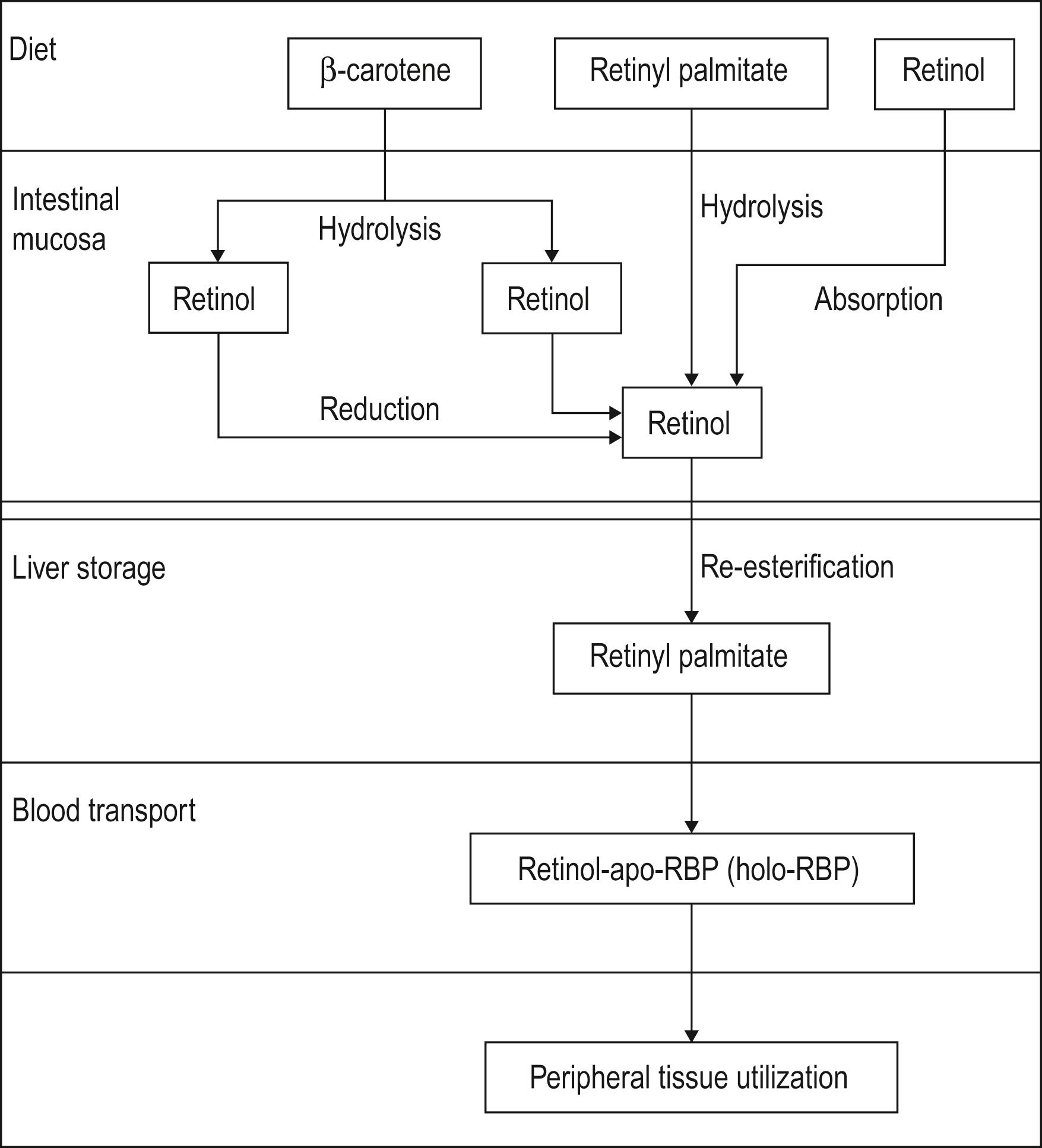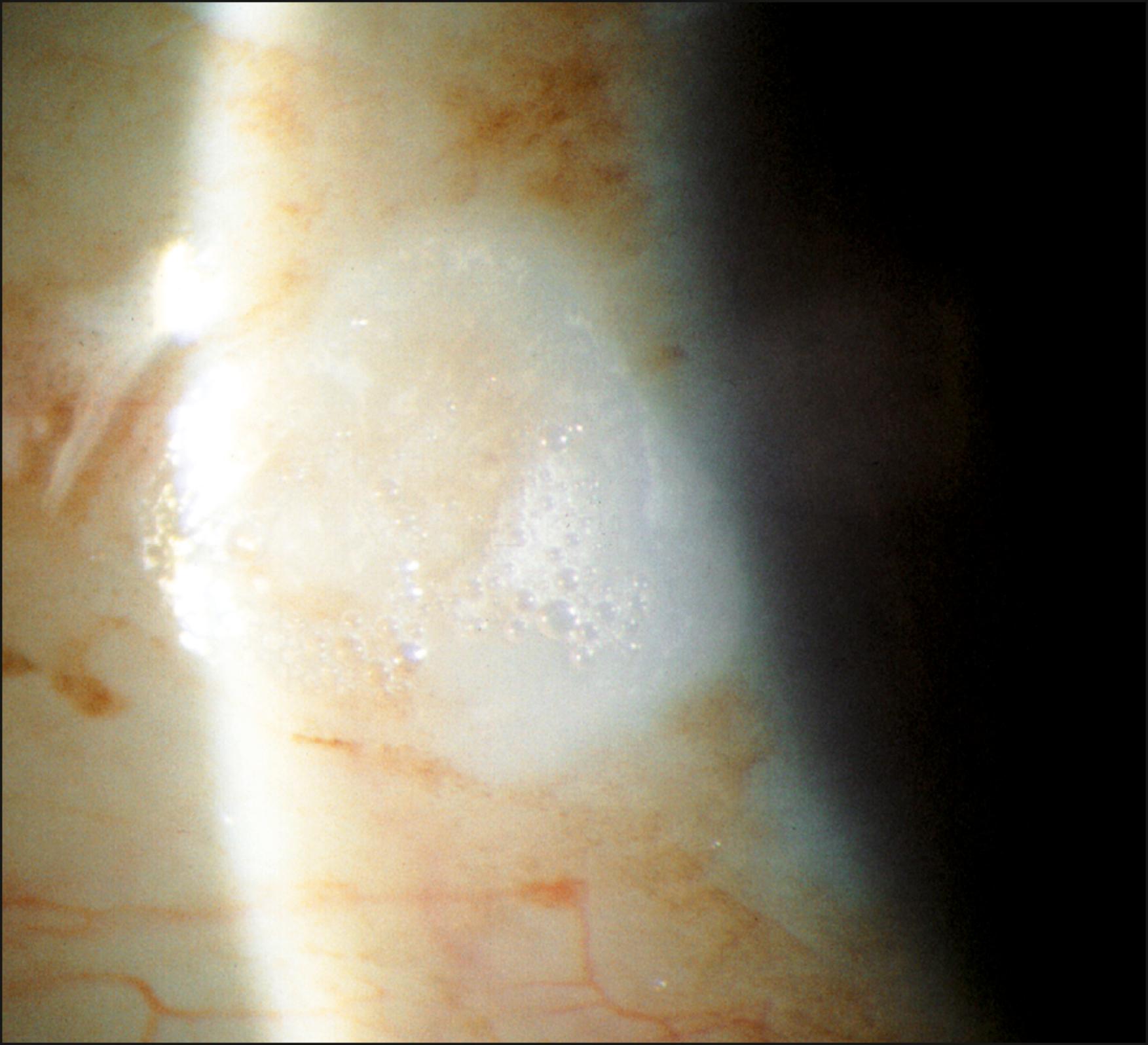Physical Address
304 North Cardinal St.
Dorchester Center, MA 02124
Vitamin A deficiency is the most important nutritional disorder with respect to the cornea clinically.
It is predominantly a disease affecting the poor in developing nations.
In the cornea, Vitamin A deficiency is characterized by the presence of Bitot spots, xerosis, and keratomalacia.
Vitamin A supplementation is the mainstay of therapy.
Other vitamin deficiencies may have some effect on corneal integrity, but evidence is scant.
All tissues throughout the body depend on adequate levels of nutrition, and the cornea is no exception. Either a deficiency or an excess of various substances can lead to altered corneal metabolism, but with few exceptions, only one is of clinical importance. The deficiency of greatest clinical significance is that of vitamin A.
† Deceased
It is estimated that as many as 190 million children worldwide are vitamin A deficient, making it the second most prevalent nutritional disorder after protein calorie malnutrition. Of these children, 5.2 million are xerophthalmic. Between 250,000 and 500,000 xerophthalmic children become blind annually, and up to half will die within 1 year of losing their vision. Improving the vitamin A status of all deficient children could prevent between 1 and 3 million deaths, with the cost of 2 days of supplementation at about 10 US cents per child. The scale of the problem is impressive, and when faced with a decrease of vitamin A levels, the cornea can undergo complete colliquative necrosis.
While this tragedy is largely borne by impoverished, developing countries, it is occasionally encountered in the developed nations. As such, clinical xerophthalmia has been observed in food faddists, psychiatric patients, and alcoholics. , Particularly important is the recognition of conditions that can lead to fat malabsorption, such as cystic fibrosis , or surgical procedures involving jejunoileal bypass, and can result in xerophthalmia. Ocular problems can be overlooked for many years because the diagnosis is not entertained.
The storage capacity of the human body is greater for fat-soluble than for water-soluble vitamins and, accordingly, under normal conditions, the liver can maintain a supply of vitamin A for 1–2 years. When intake exceeds 300–1200 μg/day of retinol or its equivalent, stores are laid down. When intake falls below this level, liver stores are drained to maintain serum retinol levels above 0.7 μmol/L. Vitamin A is found in animal foods and dairy products, usually esterified as retinyl palmitate. After ingestion, hydrolysis occurs in the small intestine, producing retinol, which is then incorporated into mixed micelles and absorbed into mucosal cells. Carotene is a naturally occurring progenitor of vitamin A produced by plants. However, the efficiency of carotenoid conversion varies among individuals, and only 50 or 60 of the 400 known carotenoids have provitamin activity. The most important of these is β-carotene, which is present in dark green leafy vegetables and certain colored fruits. Carotene, when absorbed into mucosal cells, is split into two molecules of retinaldehyde, which are then reduced to retinol. Retinol travels to the liver largely in the re-esterified form. Retinol is a highly active, membrane-toxic molecule. It is released from the liver in combination with a specific transport protein called apo-RBP (retinol-binding protein). The complex of apo-RBP and retinol is known as holo-RBP16 ( Fig. 61.1 ). Associated deficiencies of fat or protein can interfere with the metabolism of both carotene and vitamin A. However, these deficiencies seem to play a relatively minor role compared with actual vitamin A deficiency. In areas prone to kwashiorkor, even the small amounts of carotene in bananas and other produce can prevent the development of xerophthalmia. Xerophthalmia is particularly prevalent in areas such as Southeast Asia, where rice is the staple food. In all areas of endemic xerophthalmia, the diet is deficient in sources of the preformed vitamin, such as milk, eggs, and meat, and reliance is on limited amounts of the provitamin.

Xerophthalmia is one of the oldest recorded medical afflictions. Both nyctalopia (night blindness) and keratomalacia were recognized by the ancient Egyptians and Greeks. Interestingly, their treatments for these conditions frequently involved the use of animal livers. The celebrated Scottish ophthalmologist William Mackenzie was familiar with the disease, and in 1830 he published A practical treatise on the diseases of the eye , in which he refers to “conjunctiva arida.” He also elaborated on the beautifully descriptive term “myiocephalon” (head of a fly) to describe the prolapse of the iris through a softened cornea.
Probably the first person to produce xerophthalmia experimentally was the French physiologist Magendie. In 1816, he fed dogs a restrictive diet of wheat gluten, starch, and olive oil, and he mentions the development of corneal ulcers. Such animal experiments have since often been repeated. Only in 1925 in the work of Wolbach and Howe, using selectively vitamin A-deficient diets in rats, was the primacy of the vitamin’s role in the development of keratomalacia established. It was, however, a European epidemic of keratomalacia and painstaking observations by the Danish physician Bloch that confirmed the parallels in humans. ,
Vitamin A deficiency results in changes in mucosal surfaces throughout the body, and the resulting keratinizing metaplasia in the lining epithelia of the lungs and intestines is responsible for the respiratory and gastrointestinal symptoms of severely depleted children. It is in the eye that the classic signs of vitamin A deficiency can be readily observed. Because of the importance of being able to screen and evaluate treatment regimens in communities at risk, considerable care has been taken to draw up a classification for the different stages of the disease ( Box 61.1 ). This classification scheme remains the standard for xerophthalmia assessment to date.
XN Night blindness
X1A Conjunctival xerosis
X1B Bitot spots
X2 Corneal xerosis
X3A Corneal ulceration/keratomalacia less than one-third of corneal surface
X3B Corneal ulceration/keratomalacia greater than one-third of corneal surface
XS Corneal scar
XF Xerophthalmic fundus
Retinol is essential for the production of the visual pigment rhodopsin by the rod photoreceptors. In mild cases, nyctalopia or “night blindness” is apparent only after photic stress, but all patients respond rapidly to therapy with vitamin A, usually within 48 hours.
Conjunctival xerosis and Bitot spots should be considered together. The diagnosis of Bitot spots is marked by controversy. The first description was by Hubbenet (1860), but Bitot (1863) made the observation of dry scaly patches on the bulbar surface of the eye and their association with nyctalopia and lack of “corneal luster.” The observation that some Bitot spots appear in isolation (without coexisting clinical or biochemical evidence) and fail to respond to vitamin A therapy has led some to maintain that they bear no relationship to vitamin A deficiency at all. ,
Histologically, xerosis represents metaplasia of the conjunctival epithelium from its normal columnar to a stratified squamous type. A prominent granular layer is apparent, but most significant is the loss of goblet cells and the formation of a metaplastic, keratinized surface. In inverse relationship with the depletion of goblet cells is an increase in the mitotic rate of the epithelial cells, although, unlike ocular cicatricial pemphigoid where this also occurs, there is no subepithelial scarring. As an example of the extreme lengths to which the keratinizing effect can occur, there is a documented case of a calf born to a vitamin A-deficient cow that had a thick patch of hair in the center of its cornea.
Histologically, Bitot spots are tangles of keratin admixed with saprophytic bacteria and sometimes fungi. Often Corynebacterium xerosis is present, and it is suggested that since this is a gas-forming organism, it is responsible for the typical “foamy” appearance of other spots. The material can be easily scraped off. The base, however, remains xerotic, and the “spot” will recur within a few days. The deposit can be very extensive, involving the cornea as well as the conjunctiva.
The real confusion regarding the significance of Bitot spots has arisen because sometimes they are observed in individuals who have no supportive evidence of vitamin A deficiency, nor do they always disappear with supplemental vitamin therapy. Sommer has carried out a careful investigation comparing lesions responsive and those unresponsive to retinol. While numerically far less prevalent, nasally situated lesions are a more reliable sign of active deficiency. They are always less prominent than temporal lesions.
A far more significant indicator is the age of the patient. Sommer found that in those under 6 years of age, 97% of lesions disappeared rapidly; xerosis resolves within 2–5 days, and most spots resolve in 2 weeks. In children over 10 years of age, 60% were unresponsive. The general principle applies that in a child under six, especially when a history of night blindness can be established, a Bitot spot should be regarded as evidence of vitamin A deficiency. In older children, it is evidence of past or chronic suboptimal levels of retinol. From a practical point of view, given the tendency for clustering of vitamin A deficiency, when an older child is found with Bitot spots, it is probably the younger siblings who are in greater need of examination and treatment.
The development and persistence of Bitot spots are almost certainly related to exposure. Although histologic evidence is widespread early in the disease, clinically obvious xerosis is seen most commonly on the temporal conjunctiva ( Fig. 61.2 ), then nasally, then inferiorly, and finally superiorly. If excised, lesions do not recur, providing an adequate diet is maintained.

In adults, the presence of thickening, wrinkling, and pigmentation of the conjunctiva can be caused by chronic ultraviolet (UV) exposure, smoke, dust, and eye infections and should not be seen as pathognomonic of vitamin A deficiency. In children, however, dryness of the conjunctiva is always significant. While it is usual for conjunctival xerosis to precede or coexist with more severe ocular involvement, it should not be regarded as a sine qua non . Inflammation may mask (or possibly even reverse) conjunctival xerosis. In general, however, when 180 degrees of the conjunctiva is involved, then there is either established or incipient corneal disease.
Become a Clinical Tree membership for Full access and enjoy Unlimited articles
If you are a member. Log in here